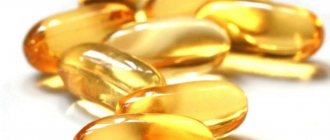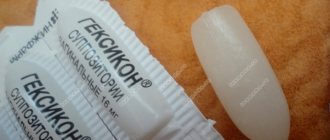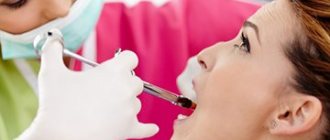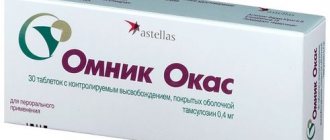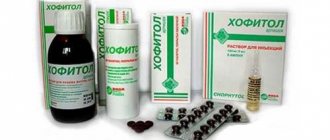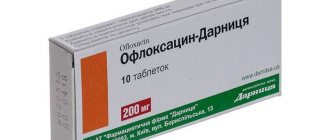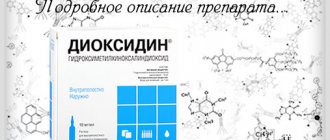Where does thyroxine synthesis occur?
In the cells of the thyroid gland, called thyrocytes, there is an active capture of molecules of microelements that enter the bloodstream from food and the production of thyroglobulin occurs.
Thyroid hormones will then be synthesized from it. Special cells of the gland - follicles - are saturated with this protein, and as soon as the body receives a signal to produce thyroxine, thyroid hormone and T3, the protein is released and converted.
For the secretion of hormones, the pituitary hormone TSH is also necessary, with its help the level of thyroid hormones is regulated. The difference between T3 and T4 is as follows:
- In the number of iodine atoms: 3 atoms in triiodothyronine and 4 in thyroxine.
- In the amount of hormones in the bloodstream: T4 is 60 times more than T3.
- How hormones work: T3 is considered the active hormone, while T4 represents the reserve of iodine-containing hormones. When needed, it releases 1 iodine atom and becomes triiodothyronine.
Thyroxine circulates in the bloodstream both in free and bound form.
In order to penetrate the body's cells, T4 combines with special transport proteins. During diagnosis, both the amount of free T4 and total T4 are calculated.
Fact!
Thyroxine is, its amount in the cells of the endocrinological organ is up to 90% of all other hormones.
Increasing T4 levels at home
Often, if there is a lack of thyroxine in the body, the endocrinologist prescribes hormonal treatment using synthetic drugs. But in some situations it is possible to increase thyroxine levels without the use of tablets.
Alternative treatment includes the following:
- Taking homeopathic remedies.
- Diet.
- Phytotherapy.
- Traditional methods of treatment.
Correction of thyroxine levels in the blood without the use of synthetic hormonal drugs is possible only in certain cases:
- with a slight deviation of indicators from the norm;
- at an early stage of identifying the problem;
- with a lack of the hormone T4, caused by iodine deficiency;
- in the absence of thyroid surgery.
Hypothyroidism should be treated only under the supervision of an endocrinologist . Independent attempts to increase thyroid hormone levels can end in disaster.
Homeopathy treatment
Many people compensate for thyroxine deficiency by taking homeopathic tablets that stimulate the endocrine system, helping to quickly solve the problem of hypothyroidism.
Patients are often prescribed drugs such as “Spongia”, “Ignacia”, “Lachesis”.
Despite the fact that these medications do not cause side effects and can be taken for a long time, they should still be treated only after consultation with a specialist.
Diet to normalize thyroxine levels
The T4 hormone contains a protein residue, as well as iodine, so you can compensate for the lack of thyroxine by following a diet in which special attention should be paid to eating foods rich in iodine and protein:
- seafood, especially red fish;
- seaweed;
- vegetables: cucumbers, tomatoes, beets, radishes;
- apples;
- baked or boiled pork, beef, turkey;
- milk;
- eggs;
- spinach.
The patient's menu must include legumes, corn, and meat - these products contain a lot of protein.
But the consumption of foods rich in fats and carbohydrates should be minimized. They reduce metabolism and slow down metabolic processes.
If the level of T4 hormone is insufficient, you must follow the principles of proper nutrition:
- Eat often, but in small portions.
- Try to eat at the same time.
- When cooking, use a minimum of salt, and only iodized salt.
- Between meals you need to drink clean water.
- Fatty, smoked foods, sweets, and baked goods should be excluded from the diet.
- You need to take care of eating plant foods every day.
- You should avoid coffee, strong tea and alcohol. These drinks can and should be replaced with herbs that help increase thyroxine in the blood.
Remember that moderate and severe forms of hypothyroidism require strict treatment under the supervision of a specialist.
Herbal medicine to normalize thyroxine levels
Herbal treatment for hypothyroidism is a popular way to increase the amount of T4 hormone.
Useful herbs for the normal functioning of the endocrine system are: cocklebur, chamomile, St. John's wort, motherwort, calendula, anise, celandine, chicory and others.
Let's consider the most popular recipes for preparing medicinal teas to normalize thyroxine levels:
Iodine-containing herb xanthium . Another name for this herb is cocklebur; this plant is a leader in iodine content. If there is a deficiency of thyroxine, it is useful to take a decoction or juice from this plant (15 drops of pure xanthium or 150 ml of decoction 3 times a day).
Ginseng tincture . Take 10 drops three times a day. Duration of treatment – 1 month. You can buy the tincture at a pharmacy or prepare it yourself.
A complete recovery from hypothyroidism is possible only with a transient form of the disease, that is, when the symptoms of the disease disappear within six months.
In other cases, the patient will need to adhere to a lifelong diet and also take hormonal medications for the rest of his life.
A decoction of five components . Take equal quantities (1 teaspoon each) of rose hips, St. John's wort, celandine, angelica and licorice root.
Chop all the herbs and fruits and pour 1 liter of boiling water. Place on low heat, simmer for 10 minutes, strain. Take 150 ml 3 times a day.
A decoction of parsley, cocklebur, agrimony . Take an equal share of all the plants and mix. Pour one tablespoon of the mixture into 250 ml of boiling water.
Keep the mixture in a water bath for no more than 10 minutes, strain, and cool. Dilute the product with boiled cool water, bring the broth to the initial volume. Take 1 tablespoon before breakfast, lunch and dinner.
Herbal medicine will produce results only with complex treatment of thyroxine hormone deficiency. Herbal medicine is not suitable as the only method of treatment.
Delicious medicinal tea with rose hips, raspberries and currants . Take 1 tablespoon of fresh berries and rose hips, chop the ingredients, mix them. Place one spoonful of the mixture in a thermos and pour boiling water over it. Leave for 1 hour, strain, drink instead of tea throughout the day.
Stinging nettle to increase thyroxine levels . Pour two tablespoons of the already dry plant into 300 ml of boiling water. Leave for 1 hour, strain. Take 100 ml three times a day before meals.
Nettle helps get rid of symptoms of T4 deficiency such as painful menstruation, vitamin deficiency, and metabolic disorders.
Tincture with buckthorn . Buckthorn normalizes the level of thyroid hormones, helps cope with obesity caused by a lack of thyroxine, and has a calming effect.
Take 1 tablespoon of buckthorn berries, brew them in 250 ml of boiling water. Let it brew for at least 2 hours, strain, and take 150 ml before meals.
Functions of thyroxine
Thyroxine is a hormone that performs the following functions:
- Strengthens metabolism.
- Improves the supply of oxygen to body tissues.
- Participates in the work of the central nervous system.
- Improves heart function.
- Affects the functioning of cells of internal organs.
- Regulates the operation of the thermodynamic system.
- Affects the thickening of the mucous membrane of the female genital organs.
The main functions of thyroxine are catabolism, that is, with its help, energy resources are released from fats and glycogen.
An increase in the hormone thyroxine in the bloodstream increases the speed of all processes in the body and a person can begin to lose weight and change psychologically.
We recommend you find out: Are your thyroid hormones normal?
The normal level of thyroxine provides the body with the following positive dynamics:
- maintaining an optimal fat layer;
- normalization of blood composition;
- balance of skeletal development;
- maintaining cholesterol levels.
Under certain conditions, excess thyroxine in the bloodstream can become normal. These are, first of all, the following states:
- the onset of pregnancy;
- treatment with certain medications;
- diseases of the liver tissue.
Diagnosis of thyroid function must be carried out taking into account these conditions.
What is thyroxine
Thyroxine is a natural hormone that is present in the body of every healthy person. Without such a hormone, protein synthesis is impossible, and therefore the normal functioning of the digestive organs.
It is based on a synthetically created analogue of the hormone thyroxine. It is produced by the thyroid gland of the human body. The hormone is responsible for the process of protein breakdown. Under its influence, carbohydrates are converted into clean energy rather than stored as fat.
In the body of a person who suffers from excess weight, the hormone thyroxine is quite small. Therefore, it needs to be artificially replenished. This is why levothyroxine sodium was invented. Its common name is L-Thyroxine.
Anyone who has too little of the hormone or whose thyroid gland does not produce it for some reason often suffers from excess weight.
Hormone diagram
Thyroxine is capable of:
- increase the need of cells for oxygen;
- speed up metabolism in general;
- increase blood flow, sweating;
- remove excess water from the body;
- reduce appetite;
- increase endurance.
The synthetic analogue of the hormone, L-Thyroxine, has exactly the same abilities. Its benefits have been proven in practice experimentally.
Free thyroxine
The most indicative clinically is the thyroid hormone thyroxine, which is presented in a free state. This hormone does not affect only the following human organs:
- male gonads;
- gray matter cells;
- spleen
There is not much T4 available, only less than 1 percent of the total amount of thyroxine in the bloodstream. But its indicators are of great importance for diagnosing pathologies in the thyroid gland.
It is free T4 that is involved in the oxidation of body tissues and when it decreases, the supply of oxygen begins to decrease.
Application of medicine
L thyroxine Berlin Chemi, the price of which is low, is recommended to be taken once a day. It is best to take the tablets in the morning, half an hour before meals. Tablets must not be chewed or crushed beforehand. They should be swallowed whole and washed down with plenty of water.
If the drug is used to treat infants, the tablet must first be dissolved in water. Before eating in the morning, it is recommended that the patient be given a suspension. Every day you need to prepare a new dosage of the medicine. L thyroxine instructions for use for weight loss and for various diseases require use after consultation with a doctor, who determines the dosage in accordance with weight, individual characteristics and the etiology of the disease.
At the initial stage of treatment of the disease, adult patients are recommended to take from 25 to 100 mcg. If necessary, the doctor may increase the dosage to achieve a therapeutic effect. Small children should be given from 12.5 to 50 mcg of the drug per day.
If the patient has malignant tumors in the thyroid gland, he is recommended to take 150-300 mcg of the drug. For diagnostic purposes, the use of 200 mcg of the drug is recommended.
Hormone deficiency and causes of deficiency
Factors influencing a decrease in thyroid hormone levels may include the following pathologies:
- Lack of iodine in the diet.
- Damage to the pituitary gland or hypothalamus.
- Lack of protein in the diet.
- Work in chemical production.
- Regular violation of work and rest schedules.
- Taking medications, hormones.
- Alcoholism or drug addiction.
Such reasons can cause a lack of thyroxine, as well as provoke an enlargement of the thyroid gland, which will affect not only the patient’s well-being, but also his appearance.
Fact!
Removal of the thyroid gland is a factor in stopping the synthesis of thyroxine. After surgery, mandatory lifelong hormone therapy is required; L-thyroxine is used.
Symptoms of deficiency
Symptoms of reduced levels of thyroid hormones will include the following:
- sluggish apathetic state;
- deterioration of intellectual abilities;
- dry skin, brittle nails;
- weight gain;
- decrease in body temperature;
- swelling and poor bowel function;
- the occurrence of disturbances in the functioning of the heart.
Prolonged ignoring of these symptoms can negatively affect the functioning of the body as a whole: a regular insufficient amount of T4 causes a hypothyroid coma, which can be provoked by an infectious or viral disease.
The severe course of this pathology can cause death.
Hypofunction in children
A decrease in the amount of thyroxine in the blood of a newborn or young child poses a great danger. This is fraught with the following disorders:
- violation of skeletal development;
- intellectual development disorder;
- mental retardation;
- changes in appearance;
- swollen, enlarged tongue;
- disorder of all body reactions.
We recommend you find out: Reasons for changes in thyrotropin (TSH) levels after removal of the thyroid gland
It is important to recognize that such thyroid disorders in young children are irreversible and permanently change their development, leading to lifelong disability.
It is important to correctly recognize the signs of low T4 in children, and also periodically check the hormone using a blood test.
Free blood test for T4: standards and rules for preparation
To determine whether T4 is low or high, it is necessary to submit venous blood for a biochemical analysis. Preparation:
- Stop taking hormonal medications 2 days before the test.
- The day before the procedure, do not do anything that could provoke emotional and physical stress.
- 3 hours before donating blood, stop smoking, eating, and drinking plain water.
In people of different ages, the normative values of free T4 differ. The normal thyroxine concentration for men and women over 20 years of age is 12-22 pmol/l.
For newborn children, the norms are different:
- period up to 72 hours after birth - 8.5-34.90 pmol/l;
- up to 30 days - 10.60-39.80 pmol/l.
For older children:
- up to 2 years - 6.20-30.10 pmol/l;
- from 7 to 11 years - 11.60-21.50 pmol/l;
- up to 20 years - from 12.0 to 20.60 pmol/l.
Excess hormone and causes of hypersecretion
The following ailments can cause an excess of thyroid hormones:
- Disturbances in the functioning of the genitourinary system.
- Malfunction of the liver.
- Osteochondrosis of the cervical spine.
- Autoimmune disorders.
- Failure to comply with nutritional standards, the use of large amounts of iodine-containing products in food.
- Treatment with heparin preparations.
Hypothyroidism is most often of an autoimmune nature, but can also be caused by drugs with a high iodine content (uncontrolled use of El thyroxine is an example of this).
Fact!
People with a predisposition to hyperthyroidism should avoid prolonged exposure to the sun. Irradiation greatly enhances the production of thyroxine and becomes a provoking factor in the development of hyperthyroidism.
Symptoms of excess
If the hormone thyroxine is produced in large quantities, the following symptoms may appear:
- increased work of sweat glands;
- the occurrence of partial mood swings;
- arrhythmia and tachycardia;
- weight loss;
- diarrhea;
- tremor of the limbs.
Complications of this disorder in the functioning of the thyroid gland can include osteoporosis, as well as severe disturbances in the functioning of the heart.
Thyroid-stimulating hormone (TSH) - what is it?
Thyroid-stimulating hormone, abbreviated TSH, or thyrotropin (thyrotropin) is a substance secreted by the pituitary gland to stimulate the thyroid gland. This hormone has a special secretion rhythm and is of considerable interest in the diagnosis of diseases of the thyroid gland and pituitary gland.
What is the hormone TSH responsible for?
When the thyroid gland is not working properly, the lack of its hormones (especially T4) in the blood stimulates the production of TSH. Thyrotropin causes the tissue to intensively produce hormones, and when their levels reach a certain threshold, the hormone is no longer produced.
Iodine intake table
Another interesting effect of thyroid-stimulating hormone is hypertrophy of the thyroid gland. The organ stimulated by TSH actively works, its metabolism accelerates and because of this iron increases in size, like muscles in a trained person. This is called functional hypertrophy of the thyroid gland.
Iodine is used in the synthesis of thyroid hormones. Accordingly, the higher the level of thyroid-stimulating hormone, the more iodine the thyroid gland needs.
The last two effects are especially important. With a lack of iodine, the thyroid tissue is still stimulated, but cannot properly synthesize hormones. If this condition continues long enough, complications can range from harmless cysts to potentially fatal malignancies.
Normal TSH levels
Table of TSH norms in women by age
Age
Norms
| 2 weeks | 0.7 - 11 µIU/l |
| up to 10 weeks | 0.6 - 11 µIU/l |
| Less than 2 years | 0.5 - 7 µIU/l |
| From 2 to 5 children | 0.4 - 6 µIU/l |
| Less than 14 years old | 0.4 - 5 µIU/l |
| More than 14 years | 0.3 - 4 µIU/l |
| Pregnancy, 1st trimester | 0.35 - 2.5 µIU/l |
| Pregnancy, 2nd and 3rd trimester | 0.35 - 3.0 µIU/l |
There is a daily rhythm in the release of thyroid-stimulating hormone by the pituitary gland. Thus, its highest level is determined from midnight to 4 o'clock, and the lowest - in the afternoon hours. This is why the range of normal concentrations for the hormone is so wide: 0.4 – 4.0 µU/ml. In addition, the need for it varies significantly depending on the period of life.
All figures are very approximate, since the standards for each laboratory are different, which is explained by different methods for determining TSH concentrations and calibration of devices.
For comparison, the norm when determining the concentration of thyroid-stimulating hormone using the RIA method is 0.24 – 2.9 µIU/ml, and with ELISA – 0.6 – 3.8 µIU/ml. Very often, laboratories write normal values right on the piece of paper with the result. Of course, the standards indicated there are only suitable for non-pregnant adult women. It’s better to clarify the rest by phone. This is exactly what a doctor does when dealing with a new laboratory.
Presentation
TSH during pregnancy
A significant decrease in normal values of thyroid-stimulating hormone in pregnant women is striking. During this period of life, a woman’s hormonal background changes, restructuring her body for pregnancy. One of the hormones is similar in chemical structure to TSH and can sometimes even interact with its receptor. So it turns out that it partially takes over the work of thyroid-stimulating hormone, T4 increases, inhibiting the release of the hormone. Since this occurs in each woman to varying degrees, changes in hormone levels are individual and can only be assessed by a doctor.
Infertility of women often “lies on the conscience” of thyroid-stimulating hormone, which controls the functioning of the thyroid gland. This has become so common in recent years that the search for the cause increasingly begins with checking the levels of thyroid-stimulating and thyroid hormone. By the way, male infertility can also be caused by pathology of the thyroid gland.
As for pregnancy, until the 10th week the fetal thyroid gland has not yet formed properly, and its hormones penetrate the placenta. If the level of thyroid hormones in the mother is insufficient/excessive for a long time, the development of the child is disrupted. Most often, these are disorders of brain formation, which later manifest as delayed psychomotor development.
The minimum TSH level at 10-12 weeks, that is, in the first trimester, is 0.35 - 2.5 µIU/l. In approximately every tenth pregnant woman, the hormone is reduced due to excess T4. Thyroid-stimulating hormone decreases even more during multiple pregnancies.
Women whose age is approaching 50, when the first signs of menopause appear, should be tested for T4, T3 and TSH. These three indicators are the main ones in determining the function of the thyroid gland. Thyroid diseases often accompany and/or simulate menopause.
The cessation of menstruation, the absence of pregnancy after 1 year of sexual activity without contraceptives, and a decrease in libido are the main “alarm bells” that should make you think about reproductive health and check the level of thyroid-stimulating hormone.
Increase or decrease in TSH
A TSH test is taken on an empty stomach; in advance it is recommended to avoid physical activity, stress and not to smoke. Given the significant fluctuations in hormone levels during the day, it is wise to always take repeated tests at the same time.
Elevated TSH levels are most often caused by either an excess of thyroid hormones, which suppress its synthesis, or pathology of the pituitary gland, which carries out this synthesis.
A lack of thyroid-stimulating hormone with a simultaneous increase in thyroid hormones indicates that the thyroid gland or part of it is out of control of the pituitary gland and is working autonomously and too intensively. This happens, for example, with Graves-Basedow disease, when antibodies are formed that replace thyroid-stimulating hormone and unusually strongly stimulate the thyroid gland.
Sometimes TSH is elevated, but thyroid levels are within normal limits. This happens in the first third of pregnancy or is a non-specific reaction to a serious illness, such as a heart attack.
When there is a lack of both thyroid-stimulating hormone and thyroid hormone, pituitary pathology should be suspected. In this case, the low T4 level is explained by the lack of stimulation of the thyroid gland. This happens with tumors of the pituitary gland (especially those involving its anterior lobe) or other parts of the brain, after a traumatic brain injury, brain surgery or long-term radiation exposure. Excess TSH and thyroid hormones can be caused by a pituitary tumor actively and uncontrollably synthesizing hormones. High levels of TSH stimulate the thyroid gland, causing hyperthyroidism and enlargement.
A simultaneous decrease in T4 and an increase in TSH indicates that the thyroid gland is not fully coping with its function or does not perceive signals from the pituitary gland. Lack of iodine, partial or complete removal of the thyroid gland, its fibrosis, neoplasms, genetic defect of the organ or structure of the thyroid-stimulating hormone - the causes of this condition are diverse. Normal T4 levels with excess TSH are very rare and soon give way to one of the conditions described above.
Some medications increase hormone levels: antipsychotics, iodine preparations, prednisolone and beta-blockers.
Symptoms
With an excess of TSH, the heartbeat and breathing become more frequent, blood pressure rises, anxiety appears, appetite improves, but the person loses weight. If this condition lasts long enough, the patient’s appearance acquires features characteristic of hyperthyroidism: wide open eyes, shaking hands, motor agitation, emotional instability.
A lack of TSH has the opposite effect: a person is lethargic, drowsy, uncontrollably gaining weight, the skin is swollen, apathy and depression appear. In children, this condition is called cretinism and is characterized by delayed mental and emotional development, but otherwise the symptoms are the same. Only after the disease is cured and TSH is normalized, the child will be able to catch up with the level of development of his peers.
The severity of these symptoms can be very small and therefore often ignored by the patient. Only attentiveness to loved ones and one’s own well-being more than once made it possible to make an early diagnosis. Treatment in the initial stages of the disease is always most effective.
Contrary to popular and fundamentally incorrect belief, any concentration of TSH does not directly cause any changes in well-being, and all symptoms are caused solely by its influence on the hormonal activity of the thyroid gland.
T4 hormone during pregnancy
An increase in the concentration of T4 in the blood of a pregnant woman may be normal. To be completely confident in the normal course of pregnancy, it is necessary to carry out tests for all thyroid-stimulating hormones in combination, including TSH.
It is necessary to monitor sufficient levels of the hormone thyroxine, since it is this maternal hormone that influences the intrauterine development of the nervous system of the embryo. With its help, the future work of the child’s entire central nervous system is laid out.
Free T4 most accurately characterizes the functioning of the thyroid gland in a pregnant woman. It is this that has clinical significance.
Important!
To produce T3 from T4, the microelement selenium is necessary. Without its participation, the transformation process may be slowed down, and thyroid function may be impaired.
How to take L-thyroxine correctly?
Here is a list of simple rules:
- Drink the drug strictly on an empty stomach 30 minutes before meals. This condition must be met because food reduces the absorption of thyroxine by 50%.
- L-thyroxine should be taken in the morning, as it has a tonic effect and if taken in the evening, sleep disturbance may occur.
- Levothyroxine should be taken once a day. This regimen is enough to ensure normal concentrations of the hormone in the blood for the whole day.
- There is no need to take breaks in treatment. The purpose of prescribing thyroxine is to correct the level of thyroid hormones, and the effect can be assessed by the TSH level. If you take a break from taking the drug, this indicator will be incorrect.
- You need to take the medicine for a long time. Most often, L-thyroxine is prescribed for lifelong use, since diseases that cause hypothyroidism and require the use of the drug have a chronic course and persistent damage to the thyroid gland. Therefore, in most cases, you need to tune in to long-term, possibly lifelong, taking thyroxine. In addition, there are diseases of the thyroid gland that cause temporary disruption. In this case, the duration of taking the drug is prescribed by the attending physician.
- Taking thyroxine can be combined with other drugs. Taking thyroxine can be combined with other drugs, except for absorbent drugs, which must be taken at intervals of 2-3 hours.
to contents
Dosage or how to calculate the dose of L-thyroxine
The dose calculation depends on the goals that the doctor wants to achieve. Either this is normalization of hormone levels to physiological levels, or this is deep suppression of thyroid-stimulating hormone in combination therapy for thyroid cancer. So how much L-thyroxine should you take?
For each person, the dose of El-thyroxine is individual, and therefore should be selected in each case separately. As a starting dose, a dosage of 25-50 mcg/day is usually used with a gradual increase in the dose under the control of tests: TSH, fT4 and fT3.
For people with heart problems, the dose is increased slowly, at intervals of 7-10-14 days. Young people can increase it faster, but during pregnancy the entire effective dose is prescribed at once, since waiting there can harm the development of the fetus. The increase each time should be 25-50 mcg/day.
Monitoring of these hormones should be done no earlier than 1.5 - 2 months after the last dose change. If you have been taking the medicine for a long time and you need to change the dose, then the rules remain the same.
In other words, increase by 25-50 mcg/day, wait 1.5-2 months, then retake TSH, fT3 and fT4 and evaluate the indicators.
A large dose of thyroxine is considered to be a dose exceeding 200 mcg/day. The dose of thyroxine after removal of the thyroid gland will always be greater than the dose for primary hypothyroidism due to autoimmune thyroiditis, because after surgery, as a rule, very little or no gland tissue remains, as in the case of oncology.
If you are interested in learning “L-thyroxine therapy after removal of the thyroid gland ,” then immediately follow the link.
There you will find a full article and an answer to your question.
to contents
Determination of the norm of thyroid hormones
The results of thyroid hormone levels depend on the reagents the laboratory works with.
Most often, if thyroxine in the free state is measured in pmol/l, its norm is approximately 9-19 units of measurement.
Do not forget about the necessary rules for conducting analysis:
- Strictly on an empty stomach and no later than 9 am.
- Stop taking certain medications a few days before the test.
- A few days before the test, do not drink alcohol.
- Reduce the impact of stress on the body.
We recommend you find out: How do thyroid hormones affect pregnancy planning?
All withdrawals of medications (1 Thyroxine or an entire group of drugs) must be agreed upon with the attending physician, usually an endocrinologist or therapist.
Norma T4
T4 norm indicators depend on the equipment and reagents used and may differ in different laboratories; the range of reference values is indicated on the results form.
During pregnancy, the content of thyroxine in the blood increases, and there are differences depending on age. The unit of measurement can be pmol/l or ng/dl (less commonly).
Normal free T4 values for laboratories that meet current requirements:
| Patients | Norm pmol/l |
| Men | 9-22 |
| Women | 9-22 |
| Children from 5 to 15 years old | 10,7-26,9 |
| Pregnant | 7,6-19 |
What influences the result?
Medicines that increase test results:
- Amiodarone;
- Levothyroxine;
- Propylthiouracil;
- Aspirin;
- Danazol;
- Furosemide;
- Tamoxifen.
The following drugs reduce the amount of T4 in the blood:
- Anabolic steroid;
- Phenytoin;
- Carbamazepine;
- Thyrostatics;
- Clofibrate.
When taking these medications, you cannot count on a correct test result.
It is necessary to temporarily stop taking them without causing harm to health.
special instructions
In case of hypothyroidism caused by damage to the pituitary gland, it is necessary to find out whether there is simultaneous insufficiency of the adrenal cortex. In this case, replacement therapy with glucocorticosteroids should be started before treatment of hypothyroidism with thyroid hormones is started in order to avoid the development of acute adrenal insufficiency.
It is recommended to periodically determine the concentration of thyroid-stimulating hormone (TSH) in the blood, an increase in which indicates an insufficient dose.
The drug does not affect activities related to driving vehicles and operating machinery.
When is the study scheduled?
A test for thyroxine, as well as other hormones of thyroid function, is prescribed if the following diseases are suspected:
- Hyperfunction of the gland.
- Hypofunction of the gland.
- Prevention of thyroid diseases in endemic areas.
- When prescribed treatment for any thyroid disease.
- For infertility.
- After pregnancy.
- In a newborn for 2-4 days.
If the patient is taking drugs to treat hypothyroidism, such as El thyroxine, then a T4 hormone test will show the effectiveness of this therapy.
L-Thyroxine during pregnancy and breastfeeding
During pregnancy and breastfeeding, therapy with the drug prescribed for hypothyroidism should continue. During pregnancy, an increase in the dose of the drug is required due to an increase in the level of thyroxine-binding globulin. The amount of thyroid hormone secreted in breast milk during lactation (even when treated with high doses of the drug) is not enough to cause any problems in the child.
The use of the drug in combination with antithyroid drugs during pregnancy is contraindicated, since taking levothyroxine sodium may require an increase in the dose of antithyroid drugs. Since antithyroid drugs, unlike levothyroxine sodium, can penetrate the placenta, the fetus may develop hypothyroidism.
During breastfeeding, the drug should be taken with caution, strictly in recommended doses under medical supervision.
Treatment of hormone deficiency
Hypothyroidism is treated with hormone replacement therapy and iodine supplements.
L thyroxine is considered a medicinal analogue of the natural hormone thyroxine.
It is effectively absorbed by the human body and has no side effects.
El thyroxine is taken once a day at the same time. Its dose is calculated by doctors after tests. Control tests in the first year are carried out every 3 months.
Levothyroxine affects the following processes in the human body:
- development of bone tissue;
- work of the heart muscle;
- kidney and liver function;
- oxygen absorption by the body.
The drug L thyroxine, like the natural hormone, can cause hyperthyroidism if the dose is exceeded.
Application
L thyroxine instructions for use require use if there are appropriate indications. The drug is recommended to be taken for hypothyroidism. The drug is highly effective in the treatment of euthyroid goiter.
If resection of the thyroid gland was performed, then the use of medication is recommended to prevent goiter. L thyroxine berlin chemi is recommended for use after surgery for thyroid cancer. For diffuse toxic goiter, patients are prescribed medication. If a euthyroid state has been achieved while using thyreostatics, then medication can be used. The indication for use of the drug is a thyroid suppression test. The drug is used as a diagnostic tool.
If a patient has been diagnosed with hypothyroidism for a long period of time, the drug is prescribed with caution and used under the supervision of a physician.
Possible consequences
An overdose of hormonal drugs can lead to symptoms of hyperthyroidism. This is a disorder of the nervous system - irritability, sleep disturbance, excitability.
Also:
- The heart suffers: there is a rhythm disturbance, tachycardia.
- Kidney function deteriorates and there may be swelling.
- Possible hair loss and excessive dry skin.
- Appetite increases, which leads to excess weight gain.
- Weight gain is a common consequence of hormone treatment. Therefore, it is necessary to monitor your own weight. This is not an easy task, but within reasonable limits it is doable.
- Severe courses of chronic diseases, especially of a neurological nature, are possible.
Useful video
Watch the video about taking thyroxine:
Similar articles
- Diet for autoimmune thyroiditis: main menu...
A diet for autoimmune thyroiditis is required. It is not difficult to create a basic menu for thyroid disease. If you have hypothyroidism, a gluten-free diet will help. Read more - Hypothyroidism: symptoms and treatment in women and men...
It is quite difficult to identify hypothyroidism; symptoms and treatment can only be determined by an experienced doctor. It can be subclinical, peripheral, often hidden until a certain point. For example, in women it can be detected after childbirth, in men - after surgery or injury. Read more
- Hypothyroidism: folk remedies, treatment with them, is it possible...
Often, constant drug therapy is required if hypothyroidism is diagnosed; folk remedies can only alleviate the condition. Treatment of subclinical, autoimmune diseases in women and men is carried out outside the acute stage. Is it possible to be cured forever with folk remedies and how? Read more
- Hypothyroidism in children: types - congenital, subclinical...
Hypothyroidism in children is becoming quite common. There are a lot of varieties - congenital, subclinical, primary, etc. Signs and symptoms may not always be immediately recognizable. Diagnosis begins with hormones, especially before one year. It is more important to carry out prevention so that there are no problems with psychomotor development. Read more
- Diffuse toxic goiter: causes, symptoms, degrees...
Often, diffuse toxic goiter is congenital, but it is provoked by certain factors in adulthood. Symptoms depend on the extent of the damage. An important test is hormones for Graves' disease. Diagnostics includes ultrasound, CT, biopsy and others, after which treatment is prescribed. Read more
Features of taking "L-Thyroxine"
According to reviews, L-Thyroxine helps well during pregnancy. The drug is a synthetic hormone. The active ingredient is levothyroxine. In the body, it does the work that the missing hormone should normally do. It regulates metabolism, affects cell development, helps with the functioning of the cardiovascular system, and also stimulates the central nervous system.
In the first trimester of pregnancy, L-Thyroxine takes part in the development of the embryo. In subsequent months, it helps the already formed thyroid gland of the fetus.
It is necessary to take L-Thyroxine only as prescribed by an endocrinologist. You cannot set or change the dose yourself.
Pharmacological properties
The main substance of “L-Thyroxine” is sodium levothyroxine, a chemical enantiomer of thyroxine, which in the liver is transformed in small quantities into triiodothyronine, then passes into the body’s cells and affects metabolism, as well as tissue growth.
In small dosages, the drug can have an anabolic effect on fat and protein metabolism. In medium dosages, it increases the need of tissues for oxygen, increases the functional activity of the nervous system, as well as the heart and blood vessels, activates growth and development by improving the metabolism of fats, carbohydrates and proteins. In increased doses, the active substance inhibits the production of thyroid-stimulating hormone from the pituitary gland.
The pharmacological effect appears within seven to twelve days after taking the medication. The effect persists for the same amount of time after its cessation.
For hypothyroidism, the therapeutic effect occurs after three to five days. Tissue growth throughout the endocrine organ decreases or disappears completely after six months.
After entering the body, the main microelement is absorbed almost completely in the upper part of the small intestine. The absorption of the drug is approximately eighty percent of the dose taken. When eating together, the absorption of the substance is reduced. The maximum plasma level is achieved approximately five to six hours after using L-thyroxine.
The active substance is characterized by a very high bond with albumin, thyroxine-binding prealbumin, as well as thyroxine-binding globulin. The exchange of thyroid hormones occurs mainly in the kidneys, liver and brain. A small amount of the essential trace element undergoes the process of splitting off carbon dioxide from organic acids or amino acids and removing amino groups from the molecule.
In addition, it attaches to sulfuric and glucuronic acids, mainly in the liver. The method of excretion of metabolites is through the intestines and kidneys with urine. The half-life varies from six to seven days, in people with thyrotoxicosis this process takes three to four days, in patients with hypothyroidism it takes nine to ten days.
Release form and composition of the drug
The tablets have a round and slightly convex shape. The medicine is slightly yellowish in color. On one side there is a characteristic designation with the dose of the drug. The drug "L-Thyroxine" can be found with titers of 50, 100 and 150. The tablets contain sodium levothyroxine in different dosages. The drug with the number 50 contains 50 mg of the main substance.
There are also auxiliary components. These are microcrystalline cellulose, dextrin, sodium carboxymethyl starch, partial glycerides. The medicine is packaged in blisters of 25 pieces each. The shelf life of the drug does not exceed two years.
Interaction with other drugs
The substance levothyroxine, which is part of L-Thyroxine tablets, can increase the effect of indirect anticoagulants. Therefore, it will be necessary to reduce the dosage. If you need to take antidepressants, then the drug “L-Thyroxine” will enhance their effect. You also need to increase the dosage of insulin and diabetes pills. Levothyroxine reduces their effect.
Be sure to constantly monitor your blood glucose levels. L-Thyroxine reduces the effect of heart medications. During treatment with antibacterial agents, it is necessary to increase the dosage of levothyroxine. During pregnancy and lactation, you need to increase the therapeutic dose of tablets, but only on the recommendation of a doctor. All these interaction features must be taken into account when using L-Thyroxine tablets. Functions, instructions for use - all this should be studied before starting therapy.
Take levothyroxine correctly!
Levothyroxine is a very sensitive hormone.
Its absorption from the gastrointestinal tract can be affected by both food and other drugs. This is why levothyroxine must be taken:
- Strictly on an empty stomach (preferably in the morning)
- Drink with plain water
- at least 30 minutes before eating or taking other medications (preferably 30-60 minutes)
I recommend that my patients place the tablets on the bedside table and take them immediately upon waking.
For those who often wake up at night to use the toilet, it may be convenient to take it at 4–5 am, during the next trip to the toilet. In this case, the main thing is not to forget that you have already taken the pill.
By the way, a recent study [1] showed that even a glass of milk immediately after taking the pill can significantly reduce the absorption of levothyroxine in the intestine.
It is also not recommended to take levothyroxine medications together with calcium or iron . This does not mean that they should not be taken at all.
Just try not to eat or take anything for 30-60 minutes after taking levothyroxine in the morning.
T4 increase
An increase in tetraioditronine entails the following symptoms:
- increased sweating, fatigue,
- increased irritability,
- tachycardia, arrhythmia (interruptions),
- tremor of the upper extremities,
- weight loss.
If the level of tetraiodothyronine is increased, then an increased breakdown of the body's energy reserves develops, which leads to an increased release of energy. The result of these processes is a decrease in the amount of fat, and excess energy is directed to other places, thereby enhancing normal processes - excitability, heart contractions and others. As a result, a person loses weight, but such weight loss is not useful and not physiological, since it occurs against the background of a violation of the body’s homeostasis. If the hormonal imbalance continues for a long time, disorders in the bone tissue are possible, and severe fractures may develop.
If the tests reveal a decrease or increase in free tetraiodothyronine, it is recommended to immediately contact an endocrinologist, since such indicators may indicate a functional disorder of the thyroid gland. In some cases, in addition to drug therapy, surgery may be required.
Reasons for deviation from the norm
The level of thyroid hormones is directly dependent on its functioning.
With various pathologies of this endocrine organ, the synthesis of hormones can significantly decrease or, conversely, increase to extreme numbers.
Next we will talk about the symptoms, as well as the causes of deficiency and excess of thyroxine.
So, T4 deficiency is called hypothyroidism and is characterized by the following symptoms:
- dry skin and mucous membranes;
- gaining extra pounds;
- a drop in overall vitality;
- problems with concentration and reduced performance;
- hypersensitivity to environmental temperature changes, especially cold;
- disruption of the menstrual cycle in women;
- dysfunction of the digestive system, leading to frequent constipation;
- alopecia (hair loss);
- weakening of the heart muscle, leading to the development of coronary disease, and so on.
This clinical picture is explained by a slowdown in biochemical processes in the body, which can have very serious consequences - for example, hypothyroid coma, organic damage to the heart and blood vessels.
Thyroxine deficiency can be congenital or acquired.
Biosynthesis of thyroid hormones
The development of congenital hypothyroidism is caused by genetic pathologies of the thyroid gland, improper production of thyroid hormones due to:
- the mother taking certain medications during pregnancy;
- autoimmune and infectious pathologies of the maternal body;
- influence of other reasons.
Acquired primary hypothyroidism is usually detected:
- after removal of the thyroid gland;
- as a consequence of radiation therapy or the harmful effects of increased radiation caused by unfavorable ecology;
- after taking medications containing radioactive iodine;
- for autoimmune and infectious inflammation, as well as neoplasms of the thyroid gland;
- endemic goiter;
- overdose of drugs that suppress thyroxine synthesis.
The causes of secondary and tertiary acquired hypothyroidism are:
- atherosclerosis of cerebral vessels, resulting in damage to the pituitary gland;
- inflammatory processes in the pituitary region of the brain;
- autoimmune lesions of the pituitary gland;
- toxic drug poisoning causing pituitary dysfunction;
- meningoencephalitis involving the hypothalamus;
- brain injuries and tumors;
- the use of serotonin as a therapeutic agent.
Excessive production of thyroxine is called hyperthyroidism. It is characterized by the following symptoms:
- increased heartbeat (tachycardia);
- a stable state of increased anxiety and irritability;
- periodic problems with falling asleep, frequent insomnia;
- tremor of the limbs;
- redness of the eyes and subsequent decrease in visual acuity;
- sudden weight loss;
- swelling, especially noticeable on the face;
- frequent digestive disorders.
Increased synthesis of the hormone thyroxine by the thyroid gland significantly reduces the period of fat breakdown, resulting in the release of excess energy. This leads to an acceleration of processes in the body, as a result of which organs and systems begin to work under increased load. The development of hyperthyroidism may be due to:
- the presence of diffuse or nodular toxic goiter;
- inflammation of the thyroid gland due to viral infections;
- pituitary tumors;
- hyperfunction of the thyroid gland due to the introduction of large amounts of iodine into the body.
Those who do not have serious pathologies of the body, do not suffer from a deficiency or excess of T4, may not be afraid of obesity. By controlling metabolism, thyroxine reacts to the amount of food consumed: with an increase in its quantity, it is able to speed up metabolism and promote more active fat burning.
An imbalance of thyroid hormones entails the risk of developing many pathologies, so you should not waste time waiting for everything to improve naturally.
Problems of the thyroid gland in most cases are a consequence of functional disorders of other organs and systems, so special therapy is necessary. As a rule, it includes treatment of the underlying pathology and taking hormonal medications.
It is important to understand that if you find clear signs of a deficiency or excess of thyroxine, you should not self-medicate, risking your health and life. You just need to make an appointment with an endocrinologist, who is probably at the nearest clinic.
What is better to take?
When patients communicate, rumors arise that one drug helps better than another. But the effectiveness of the drug is influenced by the quality of the raw materials and its storage conditions. Because of this difference and personal tolerance of the remedy, people judge which medicine is better.
Original drugs produced by German manufacturers turn out to be more effective than L-Thyroxine produced in Russia. The reason for this may also be the quality of raw materials and non-compliance with production technology. The popularity of L-Thyroxine is due to its low price compared to its analogue.
The choice of the drug, its dosage and duration of treatment always remains with the doctor. The treating endocrinologist can replace Eutirox with its analogue if the effectiveness of the initially chosen medication is low.
When taking thyroid medication, you must follow the following rules:
- do not combine both drugs;
- do not take them alternately;
- If any remedy is prescribed, but the pharmacy does not have it, you need to consult a doctor.
The popularity of L-Thyroxine is due to its low price compared to its analogue.
During pregnancy
Deficiency of thyroid hormones during pregnancy negatively affects the formation of the nervous system of the unborn child. The congenital consequence of this is cretinism. Therefore, previously, women with hypothyroidism detected during pregnancy were recommended to terminate the pregnancy. But the advent of synthetic hormone substitutes in the form of L-Thyroxine or Eutirox made it possible to eliminate this problem.
Most often, women with insufficient thyroid function suffer from dysmenorrhea, and their ability to become pregnant is sharply reduced due to disturbances in the production of progesterone and estrogen. If hypothyroidism is detected before pregnancy, therapy cannot be interrupted. Lack of hormones can cause miscarriage, stillbirth, or premature birth.
It must be taken into account that the body’s need for hormone replacement therapy increases. If the patient becomes pregnant while being treated for hypothyroidism, the patient should notify her endocrinologist about this event. It is prohibited to increase the dosage of medications on your own. Antithyroid drugs should not be combined with taking Eutirox or its analogue. Treatment must be carried out under the supervision of both an endocrinologist and a gynecologist in order to detect conditions dangerous to the fetus in time.
Consequences of a lack of thyroid hormones
Deficiency and hormonal imbalance of a number of T4, T3 and TSH cause:
- depressed mental state,
- chills,
- lethargy, hypersomnia,
- inhibition of mental reactions,
- weakening of memory and attention,
- dyspnea,
- muscle spasms and pain,
- brittle hair, nails, dry skin,
- predisposition to constipation,
- tendency to obesity.
Among non-infectious human diseases, iodine deficiency diseases are common. These include an enlarged thyroid gland - endemic goiter (diffuse non-toxic goiter). The presence of thyroid hormones in the body below normal levels not only causes goiter, but can cause irreversible harm to health.
Iodine deficiency in a developing fetus and in young children can lead to a decline in mental development (from mental retardation to cretinism), speech and hearing disorders, and impaired physical development.
Women suffer from abnormalities in their reproductive function, accompanied by miscarriages and stillbirths.
Adults experience disturbances in the thinking process, sudden loss of cognitive function, and other abnormalities. The most negative traces of iodine deficiency affect the early stages of a child’s formation, starting from intrauterine development.
More than a quarter of people on the planet have an unnaturally low level of iodine intake, which increases the likelihood of thyroid disease.
The main source of iodine for the body is food; only a tenth of the requirement comes from water and from the air. The daily requirement for infants is 50 mcg, for children under six years old - 90 mcg, for children under twelve years old - 120 mcg, for adolescents and adults - 150 mcg, for pregnant and lactating women - about 200 mcg. It is useful to introduce iodine-fortified foods into your diet. Red caviar, persimmon, buckwheat, cod liver, seaweed - this is an incomplete list of such products.
Over the course of his entire life, a person consumes about one teaspoon of iodine.
Contraindications for use
It must be remembered that L-Thyroxine is a hormonal drug. It must be taken with caution.
This medicine increases the amount of the hormone in a person’s blood, so use at healthy levels or at elevated levels is strictly prohibited. During pregnancy, inattention can lead to fatal consequences.
If there is an allergic reaction to levothyroxine or any excipient, the drug is prohibited. For example, if you were allergic to lactose, this should be taken into account.
The presence of acute insufficiency of the adrenal glands and pituitary gland is also a contraindication to the use of the drug. Only after treating these conditions can we talk about prescribing L-Thyroxine.
The medicine is also prohibited if there are acute cardiovascular diseases: acute heart attack, acute myocarditis.
L-Thyroxine is prescribed to young children and the elderly with caution.
But the main contraindication is only allergic intolerance to the drug. In other cases, in consultation with an experienced doctor, the appointment is permissible with constant monitoring by an endocrinologist.



